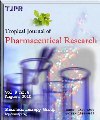
|
Tropical Journal of Pharmaceutical Research
Pharmacotherapy Group, Faculty of Pharmacy, University of Benin, Benin City, Nigeria
ISSN: 1596-5996
EISSN: 1596-5996
Vol. 15, No. 10, 2016, pp. 2289-2295
|
 Bioline Code: pr16302
Bioline Code: pr16302
Full paper language: English
Document type: Research Article
Document available free of charge
|
|
|
Tropical Journal of Pharmaceutical Research, Vol. 15, No. 10, 2016, pp. 2289-2295
| en |
Identification of clinically significant drug-drug interactions in cardiac intensive care units of two tertiary care hospitals in Peshawar, Pakistan
Shakeel, Faisal; Khan, Jamshaid Ali; Aamir, Muhammad; Shareef, Rabeea & Shah, Nazia
Abstract
Purpose: To identify clinically significant potential drug-drug interactions in cardiac intensive care units
of two tertiary care hospitals in Peshawar, Pakistan, and to compare the various potential drug-drug
interactions related parameters between the government and private hospitals included in the study.
Method: A prospective study was conducted in the cardiac intensive care units of the two hospitals, viz,
Lady Reading Hospital Peshawar (LRH) and Northwest General Hospital and Research Center
Peshawar (NWGH &RC), which are government and private hospitals, respectively. Samples of 260
and 250 patients from LRH and NWGH & RC, respectively, were evaluated. Patient medication charts
were evaluated for potential drug-drug interactions and clinically significant potential drug-drug
interactions using Micromedex DrugReax. The data were statistically analyzed.
Results: A high prevalence of potential drug-drug interactions was reported in both hospitals: 92 and
96.9 % in Northwest General Hospital and Research Center, and Lady Reading Hospital, respectively,
of which half were clinically significant. A total of 19 interacting drug pairs contributed to the clinically
significant potential drug-drug interactions. Independent sample t-test showed a significant difference in
the potential drug-drug interactions of both hospitals. Furthermore, a significant relationship was found
between the number of potential drug-drug interactions, on the one hand, and the number of prescribed
drugs and age, on the other.
Conclusion: A high prevalence of potential drug-drug interactions, particularly clinically significant
potential drug-drug interactions, calls for proper identification of these interactions and monitoring of
patients to minimize adverse outcomes and improve patient therapy.
Keywords
Pharmacy service; Drug interactions; Critical/intensive care; Adverse outcomes
|
| |
© Copyright 2016 - Pharmacotherapy Group, Faculty of Pharmacy, University of Benin, Benin City, 300001 Nigeria.
Alternative site location: http://www.tjpr.org
|
|
